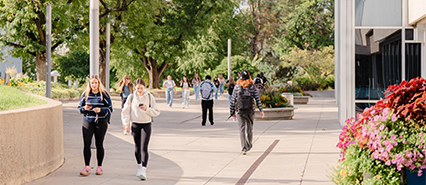Portfolio

All portfolios will be submitted electronically. The chart below lists the materials that should be submitted electronically and those materials that should be submitted in paper in a binder.
Instructions
- Instructions for Ed 301 students
- Instructions for Alternative Licensure
- Instructions for Masters of Education students
- Instructions for all students admitted to School
What is a Portfolio?
A portfolio is simply a well-organized collection of items selected to demonstrate a student’s expertise, experiences, and talents as a teacher. It also includes reflections on the contents, helping evaluate his/her teaching proficiency and guide future learning efforts.
As students plan their portfolios, they should remember that the reviewer will be using the materials included to evaluate what they know about teaching, what they can do as a beginning teacher, and whether they will continue to learn and develop as a teacher.
A great many items are not needed to demonstrate proficiency. Items should be chosen carefully, avoiding redundant materials. All items selected should indeed demonstrate the specific standards for which they have been chosen.
Steps in Completing the Process
Information on how to complete the application process occurs in ED 301/560. The purpose of the portfolio in this process is to allow students to demonstrate beginning proficiency on important teaching standards and benchmarks.
Students will build upon this portfolio throughout their program, submitting it again at admission to student teaching and at program completion. Important steps in completing the portfolio include:
- Understanding the Portfolio Requirements: Read the Teacher Handbook carefully and ask questions when information is unclear.
- Gathering Materials for the Portfolio:Begin to gather some materials immediately (e.g., those materials from classes completed in earlier semesters). Others will be accomplished later in the semester as you complete required Education courses. If materials completed in an earlier class are submitted (e.g., a philosophy of education paper), use faculty feedback to improve content and appearance. Keep electronic copies of your papers and other documents. An electronic file of a paper can be easily added into the electronic portfolio.
- Gaining Recommendations: Although some recommendations may need to wait until later in the semester when faculty and teachers know you better, start early.
- Organizing and Adding Materials As You Proceed: Do not wait until the week before the application is due – that’s too late to start the process.
- Completing Reflections and Summaries: As sections of the portfolio are completed, compose the reflection for each area.
- Submitting the Portfolio on Time: Portfolios are submitted in two parts. The exact date that portfolios are due will be posted outside the TEP Office, on the TEP web site, on the Blackboard site for ED 301/560, and will be announced in ED 301/560. Usually this will be the ninth and thirteenth weeks of class.
All students will be informed of admission in writing once all portfolios have been evaluated.
Requirements
A description of the portfolio requirements for each goal area is included in the Appendices to the Teacher Handbook. For the electronic portfolio, follow the template provided in ED 301/560. Please organize the paper materials in a small folder.
- Transcripts and official documents: demonstrating student performance in university classes
- Materials:
- Developed in university classes which demonstrate proficiency on specific education standards
- Used in field experiences and videos of teaching
- Campus recommendations:
- one from content/major area
- one from education area
- one from another on-campus professor
- Off-campus recommendation: must be from field experience teacher and is computed at the end of the semester
- Personal Reflections: Must include summaries about progress
- Results: All results of formal tests
Paper Material
Check Sheet – with your name and demographic information
- Transcripts
- Faculty recommendations
- Advising forms
- Long-term planning form
Electronic Portfolio
The School of Education department has developed an online ePortfolio. You will log directly into the portfolio and upload all required documents. The eportfolio lists all required materials.
Reflections
For each goal area (8 in all) complete a one page reflective statement. This statement should include the following. A sample reflection is included in the Appendices to the Handbook.
- The standards being addressed in this section of the portfolio. List the standards and briefly explain the significant skills it covers.
- A brief explanation of how your experiences have shaped you to develop skills related to the standards. Give the reviewer insight into your point of view concerning this standard.
- A self-evaluation of your proficiency related to this standard. What are your strengths and weaknesses? Please review the documents you have submitted and evaluations and recommendations in completing this reflection.
- A professional goal related to this standard that you have for the future.
Video Clip
The video clip of your teaching should be an edited 3-5 minute long digitized clip that demonstrates an aspect of your teaching that you wish to showcase that is also related to a specific teaching standard addressed in ED 301/560. With the video clip, you should attach a file with a statement explaining to the reviewer the aspect of teaching that you are demonstrating in this clip.


